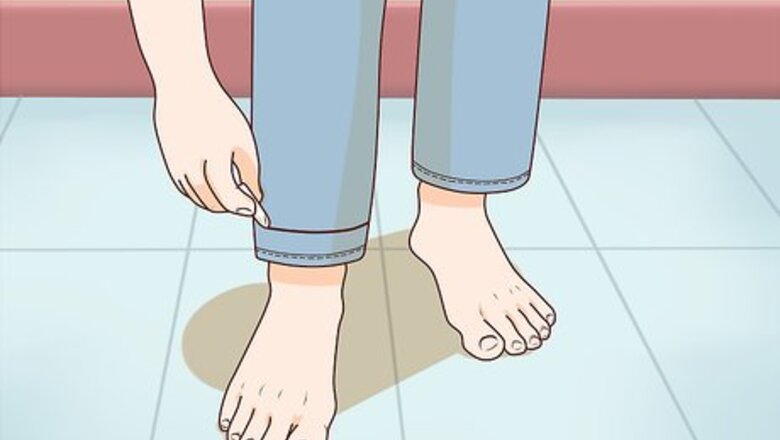
views
Trimming the Hem of Your Jeans
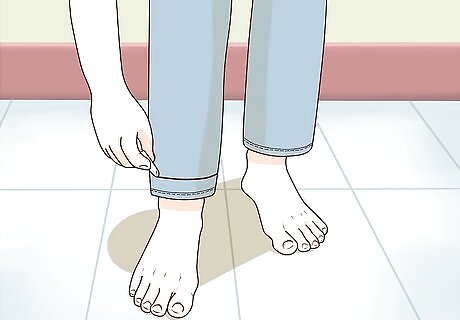
Try on the jeans and mark the length you want them to be. Put on your jeans and look in the mirror to figure out the point where you want them to stop. Once you decide on the length, make a mark with a piece of chalk or a fabric marker where you want the hem of your jeans to stop. For a modern cropped look, try hemming them so they hit right at your ankle bone. However, you can cut them to any length you like, from mid-calf capris to barely grazing the floor, depending on the length you started with. Keep in mind that unless you hem them, your jeans will fray somewhat after you cut them. If you plant to let them fray, you’ll actually need to cut about ⁄2 in (1.3 cm) below the mark, so you may want to take that into account when you’re deciding on the length. If you are planning to hem the jeans, leave an extra 1 in (2.5 cm) of length for the seams.

Take the jeans off and draw a line about ⁄2 in (1.3 cm) below the mark. Lay the jeans flat in front of you, then use your chalk or fabric marker to draw a straight line just below the mark you made for the hem. By adding the extra length, the jeans will still be the length you want after they start to fray.
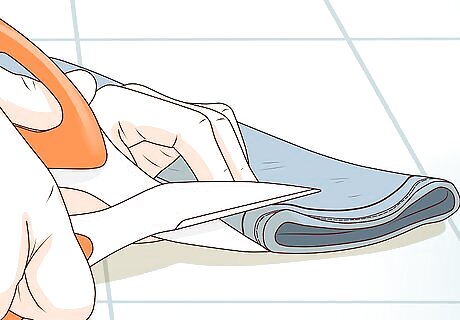
Cut along the chalk line with sharp scissors. Use a sharp pair of fabric scissors and slowly cut along one of the chalk lines you drew. Cut through one leg at a time, as trying to cut through both legs at once will make it harder to get a perfectly straight line. Do not attempt to use dull scissors to cut denim. You’ll end up with a jagged, messy-looking hem. If you’d like, after you cut the first leg, you can use the strip you removed as a template to ensure both legs are exactly the same length. Just line it up perfectly with the hem of the opposite leg, then cut along the top edge. If you’re concerned it will slip, you can pin it into place before you cut.
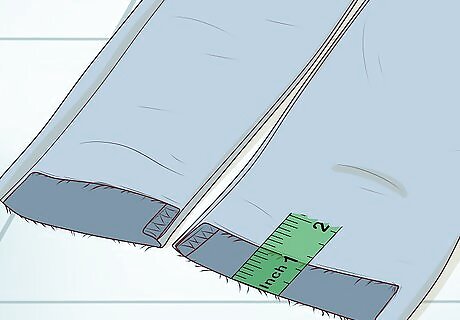
Create a step-up hem if you want your jeans to be a little shorter in the front. If you want to make your own step-up hem, lay the jeans flat again after you’ve finished cutting them. Draw a line about 1 in (2.5 cm) above the new hem, only on the front side of each leg. Cut 1 in (2.5 cm) up each side seam, then carefully cut along the new line you marked. This look combines the chic look of cropped jeans in the front with a flattering long line in the back.
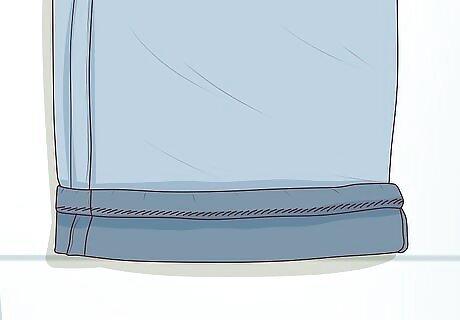
Hem your jeans if you want to keep their storebought look. To hem your jeans, roll up the ends about ⁄2 in (1.3 cm) 1-2 times, then sew the hem in place with a straight or zig-zag stitch. Sew all the way around both legs. Folding the hem twice will give you a neater edge. However, if your sewing machine isn't made for heavy fabrics like denim, only fold the hem up once. You can use thread that blends into the jeans or you can opt for a contrasting color, like yellow thread.
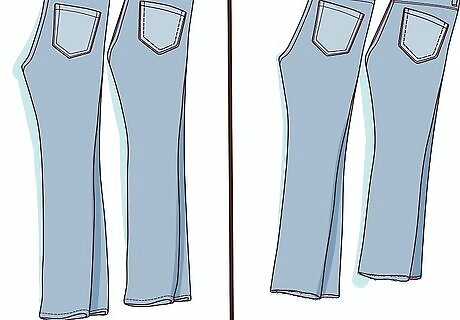
Try your pants on and check the length, adjusting if needed. Check the length of your jeans in the mirror. If they look how you wanted them to, great! If you need to take a little more off the length, repeat the process until you’re happy with the new style. If you cut your jeans too short and you don’t like how they look, consider making a pair of cutoffs instead!
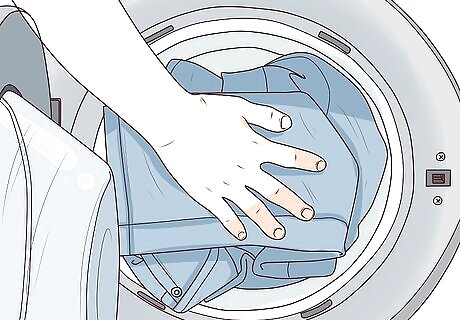
Put your jeans in the washer to fray the hem. If you want your cropped pants to have more of a frayed edge, run them through your washing machine on cold, then hang them to dry. For super-frayed jeans, finish them in the dryer. If you don’t want your jeans to fray, hand wash them as needed and hang them to dry. Use scissors to trim the white threads as they unravel.
Creating Cut-Off Shorts
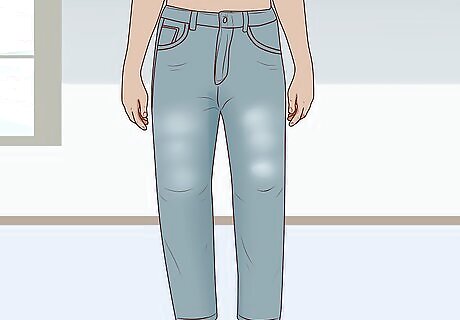
Choose jeans that are a little baggy in your legs. Jeans that are slim-fitting through your thighs will squeeze your legs awkwardly if you cut them into shorts. Look for a pair of jeans that fit you well at the waist and butt, then becomes more relaxed through the thighs. Straight-leg jeans, boyfriend cuts, and boxy high-waisted styles work well for this. If you’re in doubt, choose a pair of jeans that are about a size bigger than you normally wear. Jeans with little or no stretch will be more durable after you cut them.
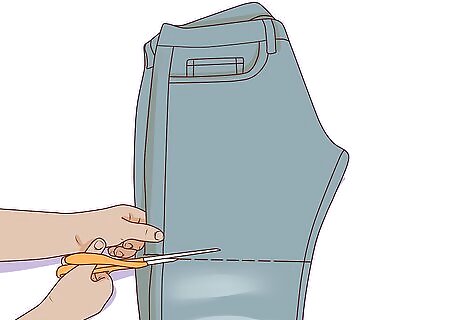
Cut off the legs of your jeans so you have long shorts. Use a sharp pair of scissors to cut the legs of the pants off from about the knees down. The cuts don't have to be perfect since you'll be measuring the length later. This will just give you less material to work with, making the whole process a little easier.
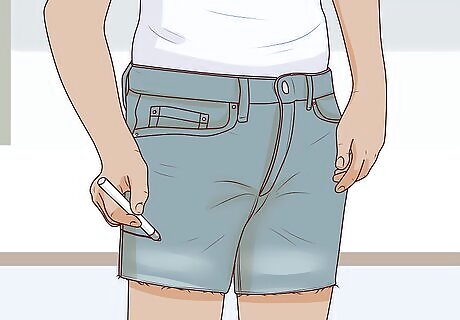
Put on your jeans and mark where you want the shorts to stop. While you’re wearing the long jean shorts, stand in front of a mirror and determine where you want them to stop. Use a fabric marker or a piece of chalk and mark the length near the outside seam. If you want to cuff your jeans, leave about an extra 2 in (5.1 cm) of fabric at the ends. Since the shorts will fray, it's best to leave an extra ⁄2 in (1.3 cm) or so on the length. Remember, it’s always better to leave them longer than to cut them too short, since you can always cut more later if you need to. Tip: If you already have a pair of shorts that are the same rise and fit as your jeans, you can use them as a template instead. Just lay the shorts on top of the jeans and mark the line where they stop. Add an extra 1/2 inch to account for the fray.
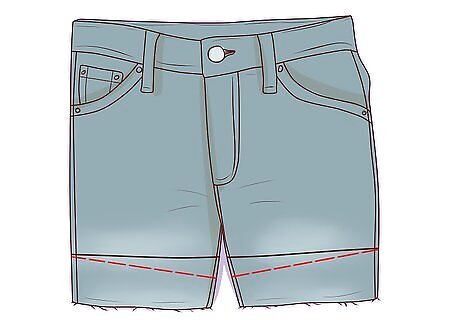
Draw a new line so the inseam is 1.5 in (3.8 cm) longer than the outside. Take the jeans off and lay them flat, then look at the mark you just made. Imagine a straight line starting from the mark you made on the outside seam and going all the way across the jeans to the inseam. Measure 1.5 in (3.8 cm) down from the end of that line and make a small mark there. Then, draw a diagonal line from the new mark up to the original mark you drew at the outside seam. If you cut straight across your jeans, the end result will actually look uneven, and you could end up exposing a lot more skin than you meant to.
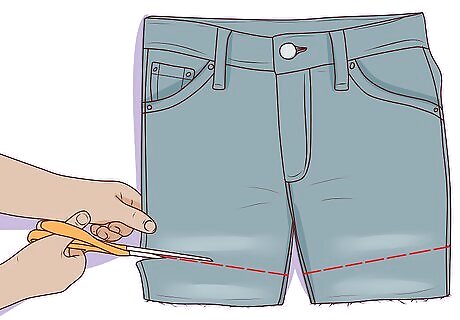
Take off the jeans and carefully cut along one of the lines you marked. Use a sharp pair of scissors to carefully cut along the diagonal line you drew. Try to keep your line as straight as possible. Using very sharp scissors will help keep you from having to stop and restart, which can result in jagged cuts.
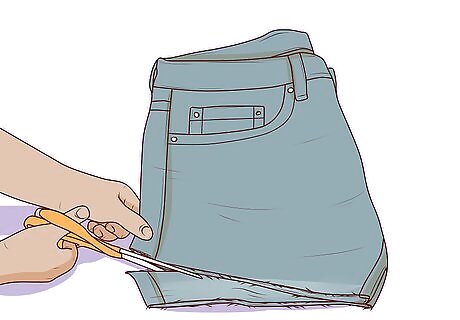
Fold the jeans in half and cut the other leg to match. Once you’ve cut the first side, fold the jeans vertically along the crotch. Smooth the denim out as much as you can, then carefully cut along the bottom edge of the shorter side. This should ensure that your pant's legs end up exactly the same length.
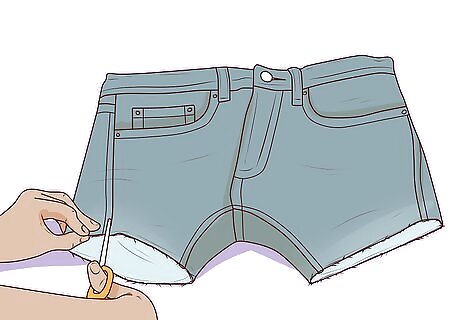
Cut small slits in the leg if the shorts are tight across your thighs. If the pants you chose weren’t baggy enough, you might notice that your new shorts seem tight in your thighs. If that happens, just make a ⁄2–1 in (1.3–2.5 cm) slit along the outside seam on each leg. This will help create more of a baggy, relaxed look.
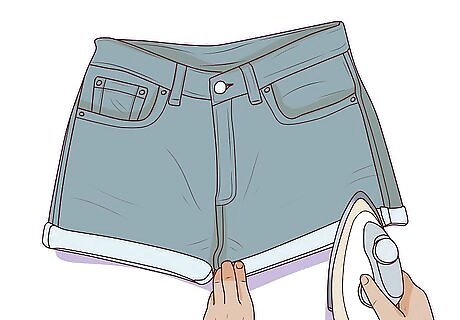
Fold the jeans up and iron them if you want them to have a cuff. If you don’t want the frayed edge on your pants to show, turn up the hem twice, about 1 in (2.5 cm) each time. Press the shorts with an iron to help hold the cuff in place. For extra security, sew a single stitch through the outside edge of each cuff.
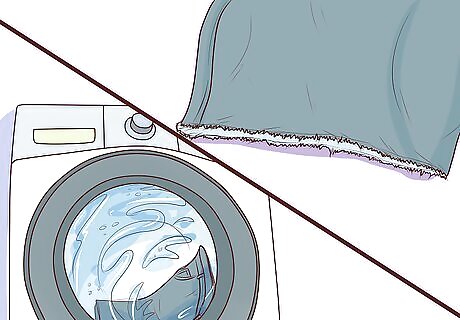
Wash and dry to create a frayed hem. If you want a distressed, aged cutoff look, toss your new jean shorts into the washing machine, then put them in the dryer. If they’re not frayed enough, wash and dry them one more time. The best way to get that lived-in look is to wear your shorts until they fray naturally!
Distressing Your Jeans
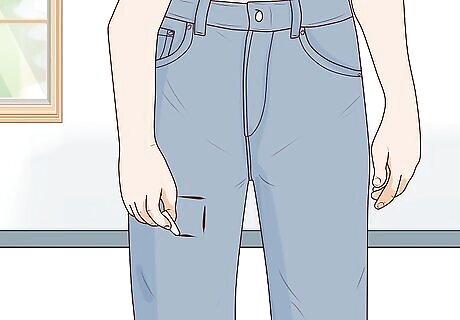
Put on your jeans and use chalk to mark the areas you want to distress. The best way to see exactly where your distressing should fall is to examine your jeans while you’re wearing them. That way, you can see right where your knees hit, or the perfect spot for a big hole so you don’t accidentally show more skin than you intended. Popular spots for distressing include the knees, thighs, and back pockets of jeans.

Take off the jeans and put thick cardboard into the legs. Placing a thick piece of cardboard inside the legs of your jeans will keep you from cutting all the way through to the other side when you’re distressing them. If you don’t have any cardboard on hand, you could also use a rolled-up newspaper.
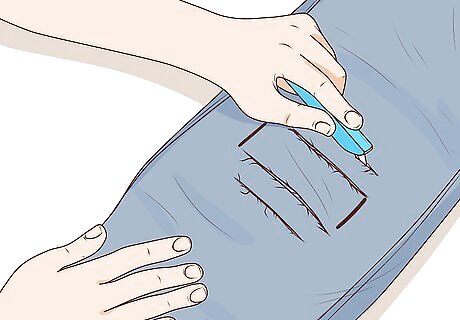
Cut horizontal strips with a box cutter if you want to make a frayed hole. Many distressed jeans feature a square hole with white threads stretched across it. To make this, use a craft knife and carefully cut 2 strips, one on top of the other, about 2 in (5.1 cm) long and ⁄2 in (1.3 cm) apart. Then, use tweezers to pick out all of the blue threads that run vertically along the strip that’s left in the middle between the slits. You’ll be left with white, horizontal threads. To make a bigger hole, add more strips, the same width apart. If you want the hole to look more natural, make the strips wider in the middle, then gradually shorter to the top and bottom, similar to the shape of a diamond.

Rub sandpaper along the denim to get a soft, worn look. Sandpaper is a great way to instantly create authentic-looking aging on your jeans. Use a coarse sandpaper, like 36-grit, and rub vigorously over the area you want to distress. Try using sandpaper around the edges of some of your other distressing to make it look even more realistic!
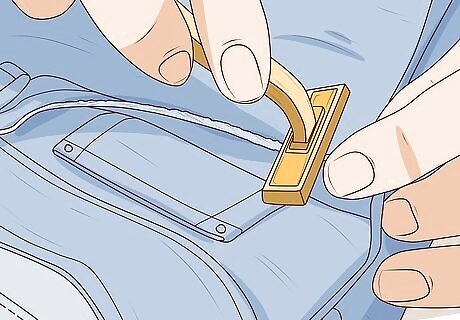
Use a disposable razor to distress thicker areas. If you want to distress the pockets, waistband, or zipper of your jeans, take a regular safety razor, like the kind you use for shaving. Scrape the razor back and forth over the denim until you get the distressed look you’re going for. This will dull the razor blade, so don’t attempt to use it for shaving after you’re finished.
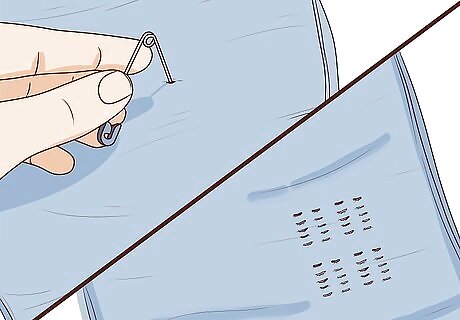
Pick at an area with a safety pin to make a small hole. If you want to add a subtle distressed touch to your jeans, take a safety pin and work it into the fibers. Pick them away with the tip of the pin until you create a small hole. This is a great way to add a subtle detail near a pocket or the waistband, for instance.



















Comments
0 comment